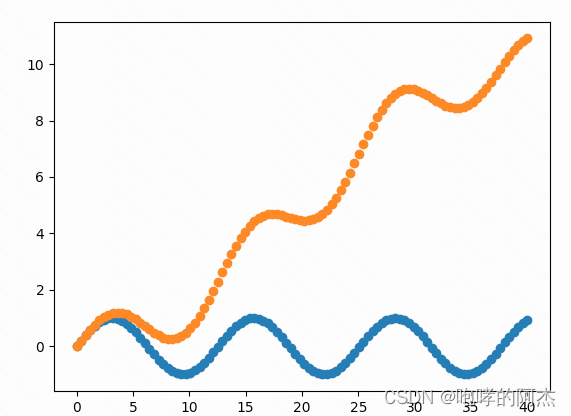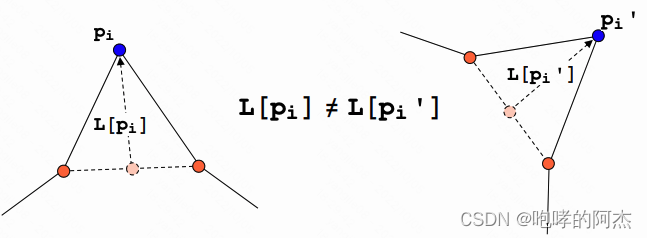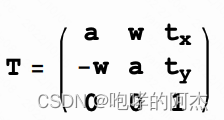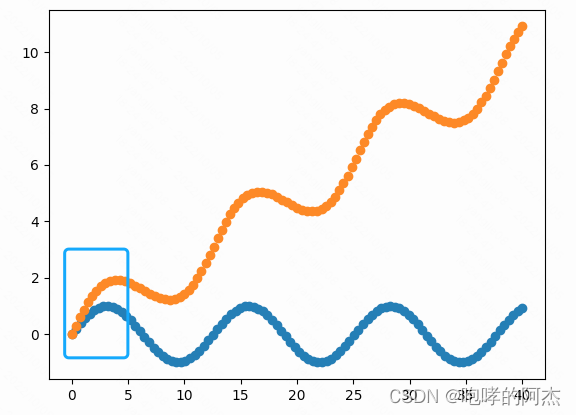背景
拉普拉斯变形是图形学处理mesh的常用方法,它假定mesh的顶点,在变化前后,顶点的拉普拉斯距离应该是一致的。
最常见的拉普拉斯矩阵的定义如下:
L
=
D
?
A
=
D
(
I
?
D
?
1
A
)
L = D- A \\ =D(I - D^{-1}A)
L=D?A=D(I?D?1A)
D是每个顶点的度,A是邻接矩阵。
假设有变形前的顶点为V,有L*V,将其拆解,可以发现就是求每个顶点
i
i
i的顶点位置减去相邻的顶点位置*(1/
d
i
d_i
di?)。
L
V
i
=
V
i
?
∑
j
∈
N
i
1
d
i
V
j
LV_i = V_i - \sum_{j\in N_i} \frac{1}{d_i}V_j
LVi?=Vi??j∈Ni?∑?di?1?Vj?
j是顶点i的邻接顶点索引。
因此,拉谱拉斯矩阵中保存了顶点的局部信息。顶点周围的关系通过这种方式记录下来。
另外,通常我们使用归一化的拉普拉斯矩阵,即
I
?
D
?
1
A
I - D^{-1}A
I?D?1A,每一行之和为1.
拉普拉斯网格变形原理
为了简单描述,本文全部以2d数据作为实验对象。
有:
- 变形前的顶点 V ∈ R n × 2 V \in R^{n \times 2} V∈Rn×2
- 锚点A:描述了几个顶点的新位置。
求:
- 变形后的顶点位置 V ′ V' V′
因此,拉普拉斯变形问题可以看成,已知网格形状,并指定一些顶点落在新的位置上,求其他未知顶点的位置,并要求所有顶点在变化前后的拉普拉斯距离一致。因此有两个优化目标:
arg?min
?
V
′
∣
∣
L
V
′
?
L
V
∣
∣
+
∣
∣
V
指定
′
?
A
∣
∣
\operatorname{arg\,min}_V' || LV' - LV|| + ||V'_{指定} - A||
argminV′?∣∣LV′?LV∣∣+∣∣V指定′??A∣∣
将LV看成b1,A看成b2,则化简为
arg?min
?
V
′
∣
∣
L
V
′
?
b
1
∣
∣
+
∣
∣
V
指定
′
?
b
2
∣
∣
\operatorname{arg\,min}_V' ||LV' - b1|| + ||V'_{指定} - b2||
argminV′?∣∣LV′?b1∣∣+∣∣V指定′??b2∣∣
形式为AX-b的优化问题,即最小二乘法。最小二乘就有很多解法了。
继续化简,因为两个式子的优化对象都是V’,因此我们可以联立方程:
∣
∣
{
L
∣
B
}
V
′
?
{
L
V
∣
A
}
∣
∣
||\{L | B\} V' - \{LV | A\} ||
∣∣{L∣B}V′?{LV∣A}∣∣
|是行拼接符号,即联立方程。B是一个特殊矩阵,他为了实现锚点的已知条件,即
V
′
=
A
V' = A
V′=A,因此B的每一行只有一个1,1的位置对应一个未知数,该未知数是锚点对应的位置。
Python实战
假设我们有一组2d点集,如蓝色的线,anchor点(黄色的点)分别对应了蓝色线在变形后的起始位置和终止位置。

求其他点的位置。
import numpy as np
from scipy.sparse import coo_matrix, block_diag
from scipy.sparse.linalg import lsqr
from collections import defaultdict
# https://github.com/SecretMG/Laplacian-Mesh-Deformation
class LaplacianDeformation:
def __init__(self, vps, faces) -> None:
self.vps = vps
self.faces = faces
self.adj_info = self.get_adj_info()
self.mode = 'mean'
self.dim = vps.shape[1]
def get_adj_info(self):
adj_dic = defaultdict(set)
for idx, face in enumerate(self.faces):
for f in face:
adj_dic[idx].add(f)
return adj_dic
def get_Ls_matrix(self, anchor_ids, anchor_weight=None):
k = anchor_ids.shape[0]
n = self.vps.shape[0]
# 生成稀疏矩阵,不建议使用np.zeros依次赋值
data = []
I = [] # 行序号
J = [] # 列序号
for i in range(n):
neighbors = [v for v in self.adj_info[i]] # ids
degree = len(neighbors)
# data += [degree] + [-1] * degree # D-A
data += [1] + [-1 / degree] * degree # (I - D^{-1}A)
I += [i] * (degree + 1)
J += [i] + neighbors
# 为了anchor增加的方程组,组成了超定方程
for i in range(k):
if anchor_weight is None:
data += [1]
else:
data += [anchor_weight[i]]
I += [n+i]
J += [anchor_ids[i]]
# [coco_matrix] https://blog.csdn.net/kittyzc/article/details/126077002
Ls = coo_matrix((data, (I, J)), shape=(n+k, n)).todense()
return Ls
def solve(self, anchors, anchor_ids):
k = anchor_ids.shape[0]
n = self.vps.shape[0]
Ls = self.get_Ls_matrix(anchor_ids)
print(Ls)
delta = Ls.dot(self.vps) # n+k, dim
# print(delta.shape);exit()
# 为后k行的原始顶点坐标修改为anchor的坐标(即修改为人为指定的已知条件)
for i in range(k):
delta[n+i] = anchors[i]
# update mesh vertices with least-squares solution
res = np.zeros((n, self.dim))
delta = np.array(delta)
for i in range(self.dim):
# res[:, i] = lsqr(Ls, delta[:, i])[0] # n,
res[:, i] = np.linalg.pinv(Ls).dot(delta[:, i])
return res
if __name__ == '__main__':
import matplotlib.pyplot as plt
x = np.linspace(0, 40, 100)
y = np.sin(0.5*x)
anchor_ids = np.array([100, 1]) - 1
anchors = np.array([x[-1], y[-1]+10, x[0], y[0]]).reshape(-1, 2)
vps = np.stack((x, y), axis=1) # n, 2
faces = []
for idx in range(len(x)):
if idx == 0:
faces.append((idx+1,))
elif idx == (len(x)-1):
faces.append((idx-1,))
else:
faces.append((idx-1, idx+1))
model = LaplacianDeformation(vps, faces)
new_pnts = model.solve(anchors, anchor_ids)
plt.scatter(x, y)
plt.scatter(new_pnts[:, 0], new_pnts[:, 1])
plt.show()

代码借鉴了一些github代码,已经在注释给出。
如果有想应用在3d点上,则需要一些修改。
带有旋转的拉普拉斯变形
上一节展示的拉普拉斯矩阵有一个问题,当顶点变形涉及到旋转变化或者近似旋转的变化,即便形状一样,但是拉普拉斯距离已经发生了变化。

因此,在Laplacian Surface Editing原文论文中还提到了一种更准确的拉普拉斯变形方法。
首先假设每个顶点的旋转都是比较小,将旋转矩阵近似为一个简单形式,

然后要求旋转前后的拉普拉斯距离相同,则约束变成:
arg?max
?
V
′
∣
∣
L
V
′
?
T
L
V
∣
∣
+
∣
∣
V
指定
′
?
A
∣
∣
\operatorname{arg\,max}_V' || LV' - TLV|| + ||V'_{指定} - A||
argmaxV′?∣∣LV′?TLV∣∣+∣∣V指定′??A∣∣
T是旋转矩阵。为了求T,设立T的求解方程为

通过求解发现,T是V’是线性关系,可以用V’的线性方程表示,接着带入约束条件,使用最小二乘法求解即可。
得到的结果如下图所示,可以发现整体的曲线更加保持了原始的正弦曲线的弧度。

# https://github.com/luost26/laplacian-surface-editing
class LaplacianDeformationWithT(LaplacianDeformation):
def __init__(self, vps, faces) -> None:
super().__init__(vps, faces)
self.extra_A = None
def get_Ls_matrix(self):
n = self.vps.shape[0]
# 生成稀疏矩阵,不建议使用np.zeros依次赋值
data = []
I = [] # 行序号
J = [] # 列序号
for i in range(n):
neighbors = [v for v in self.adj_info[i]] # ids
degree = len(neighbors)
# data += [degree] + [-1] * degree # D-A
data += [1] + [-1 / degree] * degree # (I - D^{-1}A)
I += [i] * (degree + 1)
J += [i] + neighbors
Ls = coo_matrix((data, (I, J)), shape=(n, n)).todense()
return Ls
def solve(self, anchors, anchor_ids, anchor_weight=1):
k = anchor_ids.shape[0]
n = self.vps.shape[0]
Ls = self.get_Ls_matrix() # n, n
delta = Ls.dot(self.vps) # n, dim
LS = np.zeros([self.dim*n, self.dim*n])
for idx in range(self.dim):
LS[idx*n:(idx+1)*n, idx*n:(idx+1)*n] = (-1) * Ls
# [
# [s, -w],
# [w, s],
# ]
for idx in range(n):
neighbors = [v for v in self.adj_info[idx]] # ids
ring = np.array([idx] + neighbors)
V_ring = self.vps[ring]
n_ring = V_ring.shape[0]
A = np.zeros((n_ring * self.dim, 4))
for j in range(n_ring):
A[j] = [V_ring[j,0], -V_ring[j,1], 1, 0]
A[j+n_ring] = [V_ring[j,1], V_ring[j,0], 0, 1]
# A[j+2*n_ring] = [V_ring[j,2], V_ring[j,1], -V_ring[j, 0], 0 , 0, 0, 1]
inv_A = np.linalg.pinv(A) # 4, n_ring*2
s = inv_A[0]
w = inv_A[1]
T_delta = np.stack(
[
delta[idx, 0] * s - delta[idx, 1] * w,
delta[idx, 0] * w + delta[idx, 1] * s
], axis=0
) # 2, 2*n_ring
LS[idx, np.hstack([ring, ring+n,])] += T_delta[0]
LS[idx+n, np.hstack([ring, ring+n])] += T_delta[1]
constraint_coef = []
constraint_b = []
for idx in range(k):
vps_idx = anchor_ids[idx]
tmp_coeff_x = np.zeros((self.dim * n))
tmp_coeff_x[vps_idx] = anchor_weight
tmp_coeff_y = np.zeros((self.dim * n))
tmp_coeff_y[vps_idx+n] = anchor_weight
constraint_coef.append(tmp_coeff_x)
constraint_coef.append(tmp_coeff_y)
constraint_b.append(anchor_weight * anchors[idx, 0])
constraint_b.append(anchor_weight * anchors[idx, 1])
constraint_coef = np.matrix(constraint_coef)
constraint_b = np.array(constraint_b)
A = np.vstack([LS, constraint_coef])
b = np.hstack([np.zeros(self.dim * n), constraint_b])
spA = coo_matrix(A).todense()
# 求解的时候保证shape为二维
V_prime = lsqr(spA, b)[0]
# V_prime = np.linalg.lstsq(spA, b.reshape(-1, 1), rcond=None)[0]
# V_prime = np.linalg.pinv(spA).dot(b)
new_pnts = []
for idx in range(n):
new_pnts.append(list(V_prime[idx + i*n] for i in range(self.dim)))
new_pnts = np.array(new_pnts)
return new_pnts
参考
一个国外大学课件
简单拉普拉斯网格变形-Siggraph 2004
用数学编辑3D模型(一)- Mesh Deformation with Laplacian Coordinates
github C++
github Python
图神经网络和图表征学习笔记(三)拉普拉斯矩阵与谱方法
Laplacian Deformation on 2D/3D Mesh Editing 有详细的推导
拉普拉斯变形后面有一些改进方法,论文地址为